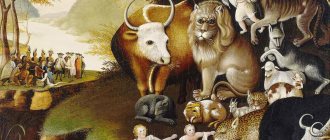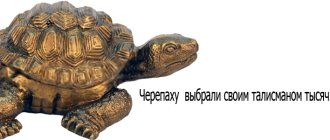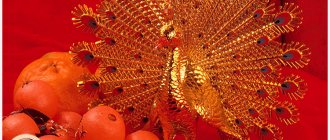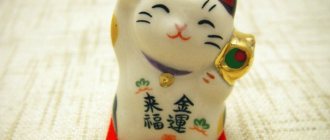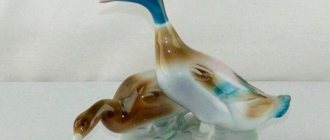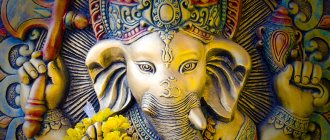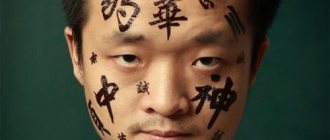Love, sex and animal symbols. Animal symbols in love - what do they mean?
Animals have long symbolized various energies, as have our animal emotions. Bears usually mean grumpiness, a bull means stubbornness, and a dog means loyalty. The elephant is a symbol of good memory, the fox is always an example of cunning for us. The lion symbolizes courage, and the mouse symbolizes timidity. These associations are universal and are the result of human observations of the surrounding nature.
Since prehistoric times, animals have acted as symbols of certain qualities. Cave paintings often depicted animals, and it is possible that the drawing of an animal surrounded by hunters was a form of sympathetic magic.
In religion, many gods are embodied in the images of animals or creatures with animal heads. An example of this is the Hindu god of wisdom Ganesh: he has the head of an elephant. In Christianity, the dove is used as a symbol of the Holy Spirit.
Throughout human history, animals are often given human characteristics. We say: wise as an owl; cunning like a fox; loyal like a dog. Mythical animals such as the dragon, sphinx or unicorn are full of symbolism. In Greek mythology, a centaur has the head of a man and the body of a horse. The centaur is associated with recklessness, drunkenness, violence and symbolizes the animal nature in man. Mermaids are often found in marine folklore. In a deck of Tarot cards, the card with the wheel of fate depicts a strange creature with the body of a man and the head of an animal. This animal could mean that humanity is still developing and even just emerging. “When I was first introduced to tarot cards, I was told that this animal was Anubis, the Egyptian god of graves and embalming, who weighed the hearts of the dead. It had the body of a man and the head of a jackal. The snake to the left of the wheel is Set, brother of Osiris and the Egyptian god of death. Therefore, Set is the sign of death, and Anubis is the sign of rebirth.”
The unicorn symbolizes virginal purity because its horn - a phallic symbol - is connected to the forehead - the seat of the mind and sublimates sexual potency into more worthy spheres. Jesus' mother Mary is often depicted with a unicorn on her lap, signifying the virgin birth. Other animals that symbolize purity are the bee, dove, elephant, phoenix and salamander.
There are animals that symbolize lust. These are donkey, bear, cat, goat, horse, leopard, monkey, pig and rabbit. In Christian art, snakes feeding on a woman's breast are sometimes symbols of vice and debauchery.
Stork
In the West, children are usually told that a stork brought them. This myth was born in Ancient Greece, where the stork was the sacred bird of Hera - the goddess of marriage, the patroness of women and children. Because storks were believed to be good parents, they gradually became associated with Hera. It was also noted that the stork takes care of its elderly parents.
Animals as an ancient symbol
In accordance with the three-member division of the World Tree, animals are distributed vertically.
- Birds are associated with the top, especially often an eagle, often some kind of fantastic bird (sometimes there are two birds symmetrically at the top of a tree, as if duplicating the sun and the month).
- The ungulates (horses, bulls, cows, deer, elk, antelopes, sheep, goats, etc.), sometimes bees, correspond to the middle; ungulates are located symmetrically on the sides of the tree, often forming a sequence of animals, hierarchically organized horizontally (for example, horses, cows, sheep, etc.).
- Corresponding with the bottom of the tree (its roots) are snakes, frogs, mice, fish, beavers, otters, sometimes bears or monsters of the chthonic type.
Similar descriptions (both verbal and in the visual arts) of the World Tree with the distribution of animals are known in abundance in ancient Near Eastern traditions, in India, Iran and China, in Siberian shamanic traditions, partly among American Indians, in old Indo-European cultures, including Slavic.
Goat
It's no secret that goat's milk is considered healing; it is called a home pharmacy. Hippocrates and Avicenna recommended drinking it. The goat Amalthea suckled Zeus, the supreme god of Olympus. Her image, like the image of a cow, is associated with fertility, maternal care, and health.
The horn of plenty is also associated with this animal; it is believed that this wonderful horn of the Amalthea goat bestows wealth and prosperity. In the east they believe that a goat can bestow creativity and success. The Slavs saw cockiness and capriciousness in the goat, hence the expression “goat-dereza.”
In addition, the goat was an everyday occurrence, it was present in almost every village house, if it was not completely poor. The expression “retired goat drummer” means that if you have lost a goat (meaning work, service, home, family) - the limit of disaster has arrived.
The wolf is a symbol of the brave
Traditionally, the wolf is an ancient symbol of malice, insatiability, devouring passion and rage. Wolves and ravens are often close friends of the primitive gods of the dead.
The ideas of the peoples of Europe about lycanthropy and werewolf are associated with wolves. The concept of lycanthropy placed the wolf on the level of a human. It was equal - friend or foe.
There were two types of werewolfism: on the one hand, the sorcerer could turn an unwanted person into a wolf, on the other hand, he could turn into a wolf himself. At the same time, it was believed that it was possible to regain one’s human appearance.
The custom of leaving the bones of a killed wolf to influence the enemy, the thief, has been preserved: a spell was cast, certain parts of the bones were broken and burned. It was believed that in this case the enemy (thief) would have the corresponding parts of the body dry out or ache.
“Wolf holidays” were celebrated in the spring, during the vernal equinox, on St. George’s Day on April 23 (old style). They are ritually associated with the cult of cranes as solar birds.
And perhaps that is why in fairy tales related to the search for the Firebird, the wolf acts as a magical assistant (“Ivan Tsarevich and the Gray Wolf”).
St. George in Rus' was called the wolf shepherd: “What the wolf has in its teeth is what George gave.”
The ancient name of the wolf, “Hort,” remained only in conspiracies.
The mummers dressed in wolf skins, jumped over tree stumps, and performed actions related to agricultural magic. This is where the word “magician” comes from - a disguised person dressed in a tow, wolf skin.
Historian and archaeologist B. A. Rybakov expresses the opinion that the priests-princes, who were not allowed to appear before the people in their usual form when performing rituals, wore skins.
The wolf is the mount of witches and warlocks; its appearance is taken by a werewolf or a werewolf.
The ancient symbol of a lush plant that has gained strength - the image of wolves with flourishing tails - is known from the decor of ancient Russian churches and ornaments on bracelets.
The ritual of dressing up in wolf skins or walking with a stuffed wolf, among many peoples of Europe (including the southern and western Slavs) was timed to coincide with the autumn-winter season.
In Christianity, the wolf is evil, the devil, the destroyer of the flock, cruelty, cunning and heresy, as well as a person with a fixed neck, since it is believed that the wolf is not able to turn around.
The wolf was the emblem of Saint Francis of Assisi, who tamed the wolf of Gubbio.
Plants of love
It is recommended to decorate the love zone with plants that help attract passion, affection and well-being for the couple. In addition, well-groomed flowers will enhance the aesthetic appeal of the bedroom interior. The best plants from the point of view of Feng Shui are:
- aichreson;
- anthurium;
- spathiphyllum;
- balsam.
Aichreson - tree of love
Aichreson is deservedly called the tree of love. This plant resembles a mini-tree, which not only decorates the interior, but also attracts the energy of family well-being into the house. Anthurium is a “male” flower, and spathiphyllum is a “female” flower. It is recommended to place both plants in the love zone. Balsam is considered the flower of love and happiness. This plant combines ease of care and a pleasant appearance, allowing you to decorate the bedroom.
Expert opinion
Melnik Dmitry
feng shui master
Couples dreaming of having a child are advised to place a ripe pomegranate fruit in the love zone. It is desirable that the fruit is slightly burst. A fake pomegranate is also suitable for decoration.
What does the Horse symbolize?
The horse is an ancient symbol of the sun and the steppe. The horse symbolizes grace and courage. Among the ancient Slavs, the horse served as a symbol of death and resurrection, like the rising and setting sun.
The loaded horse is a symbol of the human body bearing the burden of its spiritual constitution. Or, on the contrary, this symbol of the spiritual nature of man, bearing the burden of a material personality.
Horse, the horse as an ancient symbol plays an important role in many mythological systems of Eurasia. It is an attribute (or image) of a number of deities.
Gods and heroes move on horseback (across the sky and from one element or world to another). Stories about mythical horses are known in ancient Indian, Celtic and Slavic mythologies.
In the Bible, in the book of the prophet Isaiah it is said: “Woe to those who go to Egypt for help, trusting in horses and relying on chariots, because they are many, and on horsemen, because they are very strong, but do not look to the Holy One of Israel and they don’t resort to the Lord!
The Egyptians are people, not God, and their horses are flesh, not spirit” (31, 1-3). At the same time, the horse in the Bible is the embodiment of stateliness, beauty and grace, the perfect creation of God.
The groom likens his beloved to a mare in Pharaoh's chariot.
The horse is an ancient symbol of strength, speed and tireless running. A symbol of fearlessness, military valor and glory.
The horse as an ancient symbol has a dual meaning. As the solar force, a white, golden or fiery horse appears with the sun gods, harnessed to their chariots; as the lunar (moisture, sea and chaos element) force - the war horses of the oceanic gods. Thus, the horse symbolizes both life and death.
The horse also symbolizes intellect, wisdom, intelligence, reason, nobility, light, dynamic strength, agility, quickness of thought, and the passage of time.
She has an instinctive, sensitive animal nature, magical powers of deification and symbolizes the wind and sea waves. Appears in images of fertility gods.
The winged horse is the sun or the cosmic horse. As an ancient symbol it represents pure intellect, innocence, purity, life and light; it is ruled by heroes.
At a later time, the horse replaced the bull in sacrifices. Both of them personify the gods of Heaven and fertility, male power, as well as chthonic forces.
The white horse of the ocean relates to both the principle of water and the principle of fire. A lion killing a bull or a horse means the Sun, drying up moisture and fog.
A black horse is a sign of a funeral. Foretells death and symbolizes chaos. Appears during the twelve days of chaos between the old and new years. The sacrifice of the October horse means the death of death.
In Christianity, a horse is the sun, courage, nobility. Later, during the Renaissance, it began to symbolize lust. In catacomb images, the horse as an ancient symbol meant the rapid passage of time.
The four horses of the Apocalypse are war, death, famine and epidemic. The horse is the emblem of Saints George, Martin, Mauritius, Victor; wild horses are the emblem of Saint Hippolytus.
Spider
Many of us don't like spiders and would never want to meet them in real life, but the spider as an emblem in many cultures signifies hard work and creativity, personifying the energy that we put into our own projects when we work on them tirelessly - like a spider above its web.
SL bracelet with pearls and cubic zirconia (order online)
Cow as a symbol of motherhood
Symbolizes the Great Mother, all moon goddesses in their nutritional aspect, the productive power of the earth, multiplicity, childbirth, maternal instinct. The horns of a cow are the moon in an incomplete phase.
Representing both the moon and the deities of the earth, the cow is an animal both celestial and chthonic.
For many peoples, the cow, as an ancient symbol, symbolizes fertility and prosperity. The cow in many ancient and archaic religions is a symbol of fertility, abundance, and prosperity.
Steppe mice voles
Although most rodents are known to be sexually promiscuous, prairie voles break this frivolous reputation by forming monogamous pairs. Moreover, these mice demonstrate an animal model of monogamy in humans. They care for each other, snuggle for warmth, share nesting and raising responsibilities, and generally display high levels of supportive behavior.
The cat is a mystical animal
Sacred animal of many nations. Cat worship was characteristic of agricultural cultures, when people's lives depended on the safety of the crop and protection from rodents was required.
For the priests, the cat was an ancient symbol of the magnetic forces of Nature. The cat is also a symbol of eternity, as it lies curled up in a ring.
The cat, with its ability to change the shape of the pupil, symbolizes the changing power of the sun, as well as the phases of the moon and the splendor of the night. It also means everything that is done furtively; desire and freedom.
A black cat is lunar and represents evil and death (only in modern times has a black cat come to mean good luck). In witchcraft, the cat as an ancient symbol is a good friend of witches.
A black cat as a close associate of a witch means evil and bad luck. Cats and dogs can make it rain.
In other traditions (for example, in a number of Lithuanian mythological texts), the snake-wrestler cat turns into the snake-wrestler’s opponent, appearing in some cases in the form of a cat.
Perkūnas's opponent (in particular and primarily the devil) can turn into a cat or a black tom, sometimes with red eyes.
In the Latvian folklore and mythological tradition, a black devil with cow legs, when faced with thunder and lightning, turns into a black cat, trying to hide near a person.
A snake fighter, a fairy-tale hero, a conqueror of a monster, for example, Ivan Popyalov, the hero of the Belarusian fairy tale of the same name, can also turn into a cat.
The motif of the hero turning into a cat is also known in the East Slavic cycle of fairy tales about Ivan the Cat's son (more often Ivan Suchich or Ivan the Peasant Son).
In some of these fairy tales, the cat as an ancient symbol (along with him, Kotovich, the brother of Ivan Tsarevich, sometimes appears) can also be the embodiment or assistant of the serpent and the snake fighter.
Both of these functions are combined in the fairy tale about Volya Volovich, who, after each battle with a snake, encounters “Kotishche, open your eyes,” who threatens to eat him.
The hero kills a cat, puts on his skin and, disguised as a cat, enters Baba Yaga.
The opposition of the snake fighter and the snake in a transformed form (through the “cat-mouse” opposition) is widely represented in rituals and their degenerate forms - children's games.
In lower mythology, the cat acts as the embodiment (or assistant, member of the retinue) of the devil, evil spirits.
In Ukraine, there is a belief that the devil, turning into a mouse, swam across the sea to seduce Eve. The Blessed Virgin, seeing this, threw down her mitten.
From this glove a cat became and was devoured by the devil. The cat, as an ancient symbol, was considered unclean because it was eaten by the devil.
In Christianity, the cat is Satan, darkness, lust and laziness.
Cat Baiyun. A wonderful beast of Russian folklore, which received its nickname from the verb “to bayat”, to tell. Kota-Bayun's tales are endowed with magical powers; with them he strikes his enemies to death.
Swans
White swans have long become a symbol of boundless fidelity. A swan recognizes its friend by sight and will never confuse her with anyone else. He jealously protects his chosen one and cubs and, if necessary, will even attack a person. If one of the birds dies, the partner cannot stand being alone and most often dies. The love of swans is characterized by wonderful qualities: caring for each other, friendship, protection, compassion. Swan devotion is so well described in literature that the image of two swans swimming with their necks curved in the shape of a heart has become an almost universal symbol of love.
Bear as a symbol of Russia
The bear has long been one of the most enduring ancient symbols of Russia. If other animals can be defined unambiguously: cowardly like a hare, angry like a wolf, cunning like a fox, then it’s not so easy to say about a bear.
A symbol of good nature, gluttony, rage, heroic strength, clumsiness, laziness, tender maternal feelings... It's all about the bear.
The bear as an ancient symbol symbolizes resurrection (the appearance in the spring from its winter den with a bear cub), new life, and therefore initiation and rituals associated with the transition.
In heroic myths, the bear is a solar symbol.
In mythological ideas and ritual, a bear can act as a deity (in particular, dying and reborn), a cultural hero, the founder of a tradition, an ancestor, a forefather, a totem, a guardian spirit, a healing spirit, the master of the lower world, a sacred and (or) sacrificial animal , the embodiment of the soul, the giver, the animal double of a person, the shaman’s assistant, his zoomorphic hypostasis and soul, a werewolf, etc.
The bear is one of the main characters of animal epics, fairy tales, epics, songs, riddles, beliefs, conspiracies, etc.
The meaning of a bear is determined primarily by its similarity to a person, interpreted by mythopoetic consciousness as an indication of their common origin or origin from each other.
The theme of similarity or identity between a bear and a person is realized in different ways by the ritual of bear hunting, which forms the core of the cult of the bear.
A totem animal of many northern peoples, the bear as an ancient symbol served as a symbol of the connection between heaven and earth. The Arctic is the country of bears (Arctos).
The constellations Ursa Major and Ursa Minor are a symbol of the northern sky. The bear was the ritual animal of the goddess Artemis.
As a symbol of Divine retribution, the bear is mentioned in the Bible, in the tale of the prophet Elisha.
The bear is one of the animals associated with lycanthropy, werewolf. The bear man, the son of a bear and a woman, is a common character in folklore in different countries.
He controlled time (in a den the passage of time is not noticeable; in it you can sleep the whole winter as if it were one night, or live for several years, counting them as one week).
He was called the Master, Mikhail Potapych, Shaggy, Dense, Dirty - a hundred names, but “bear” (eating honey) - a typical replacement name, was rarely called, so as not to disturb the spirit of the formidable beast.
The black bear, as an ancient symbol, was a symbol of infernal forces.
Biblical texts had a decisive influence on the subsequent symbolic identification of the bear with Satan.
However, in the medieval tradition, the bear even more often denotes the sinful bodily nature of man.
In many medieval and Renaissance depictions of Adam and Eve, the bear climbing a tree symbolizes the disastrous outcome of the coming temptation; Motifs of a chained bear with similar meaning are also common in various religious and moralizing scenes.
Among the Slavs, this mighty beast is an ancient symbol of calm and peacefulness, since it becomes ferocious only when it is attacked or teased.
And the Scripture says that “the Lord will deal with his opponents like a mother bear whose cubs were stolen.”
On the other hand, the bear won people's love as a sweet tooth, and a very purposeful one: when did the bees stop the clubfoot if he was going to eat honey?
In Christianity, the bear as an ancient symbol means evil, the devil, cruelty, greed, and carnal appetite.
Bear cubs were believed to be born shapeless and were thus seen as a symbol of the transformative, regenerative power of Christianity over the pagans.
It is the emblem of Saints Blandina, Gall, Florentin, and Maximus. David's fight with the bear symbolizes the conflict between Christ and the devil.
Insects - the meaning of their symbolism
The ant is a collective insect, distinguished by its hard work and excellent social organization. Although his image is not often used to give symbolic meaning to works of art, he is credited with Confucian virtue and righteousness. But this applies to ordinary black ants. Another thing is the white ant, termite, which spoils the element of wood. The Chinese consider selfishness and a narrow vision of life to be a negative quality of an ant, which in their opinion is akin to self-interest.
The dragonfly is born of the wind, a symbol of Chinese summer, a predator among insects. Can be considered a useful friend, as well as a reminder of the fleeting nature of life's moments.
Paired with the white lotus symbol, it is used to indicate purity and height of intentions.
Bees are not a very common motif in paintings and are most often seen with some other symbol.
First of all, the bee is a pollinator of plants, so the meaning of its image is traditionally associated with men. The presence of a bee and peony flowers in the paintings hints at the state of a young man experiencing a desire for love, looking for love.
The combination of a bee and a monkey in the plot triggers the motive of social elevation, obtaining a position, a high position, and wishes for career growth.
Butterflies are a very common “inhabitant” of Chinese art. Like a bee, a butterfly with flowers symbolize a person seeking love and pleasure, with varying degrees of success:
- for example, the traditional motif of a plum blossom and a butterfly that flies to it means the search and acquisition of blissful love;
- a blooming tangerine and a butterfly symbolize a situation of unrequited love.
In addition, the presence of butterflies in the image “repeats”, enhances, increases the meaning and strength of other figurative meanings of this picture.
If an item with a butterfly symbol is given to very elderly and respectable people, it means a wish for them to prolong their life.
The most famous Chinese legend involving the presence of a butterfly refers to the dream reflections of the Taoist philosopher Zhuang Tzu: “Am I the person who dreams that he is a butterfly? Or am I a butterfly who dreamed that she was a man?
Another story of the same sage is connected with the love theme traditional for this symbol - with his pursuit of a beautiful butterfly. After which a beautiful young woman appears, with whom Chuang Tzu fell in love.
Cicada - since this insect has a complex life cycle and appears from underground, as if a magical creature, its symbol is immortality and man’s desire to prolong his life. In ancient times, cicadas made of jade were placed in the mouth of the deceased.
Firefly (glow worm) – females of which produce light to attract males. In Chinese culture, it is associated with the qualities of beauty, perseverance and loyalty. In fairy tales, fireflies help heroes, especially poor ones, illuminate their lives, provide conditions for the growth of their abilities and success in life.
Dog
The dog, almost on a par with the cat, was very revered in Ancient Egypt. The god of the underworld, Anubis, had the head of a dog. The Egyptians worshiped the star Sirius (the constellation Canis Major), and it was believed that it influenced the flooding of the Nile. In India, dogs are very revered, there are a lot of them on the streets, but they should not be harmed.
They believe that spirits come to them in the form of dogs to help. The dog often appears as a righteous, noble creature, a faithful and reliable helper. Even the Holy Scriptures contain chapters that believers should help stray dogs, take care of them and feed them.
The city of Nepal hosts a 5-day festival of lights every fall. The second day is dedicated to the dog; it is believed that they guard the gates of heaven. The Aztecs revered the dog as a protector from evil spirits. Some peoples have a custom: a dog is left in the room with the deceased. They believed that he could see and drive away evil spirits.
It was the watchdog and protective qualities of the dog that prompted the ancient Greeks to create the myth of the three-headed Cerberus - the guard of Hades. A dog has excellent hearing, taste and smell. And also a faithful friend who has the instinct to help you find the right path. Among the northern peoples, dogs carry sleds, and sometimes the musher barely even controls them. The leading dog, the leader, does everything.
Monkey
In India, they believe that the monkey embodied the features of the great Buddha. She turned out to be worthy of being a continuation of the Enlightened One on earth. She deserved this thanks to the fact that she extinguished the fire into which she was thrown for theft. Only the paws and face remained black.
Since then, this animal has been considered divine in India. According to Indian legends, monkeys helped the god Vishnu defeat the terrible and evil giant. In this country there are a lot of them in temples and on the streets. They behave really stealthily, but you can’t offend them, after all, they are a sacred animal.
